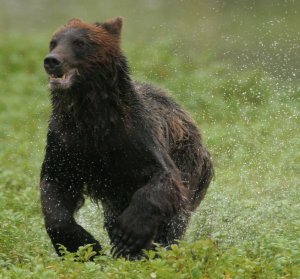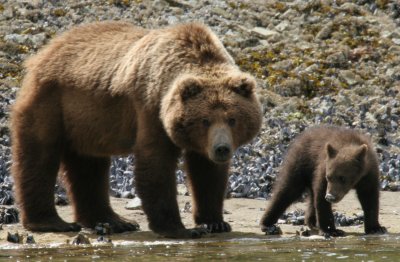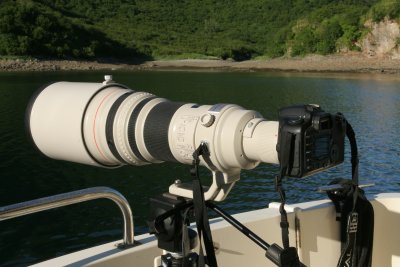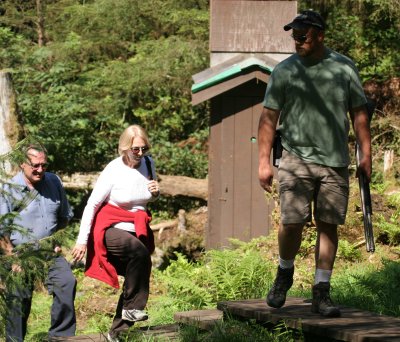Mama bear: "That's close enough."
My observing setup at Kaflia Bay.
Typical scene at a bear viewing area.
When I first heard an account of the now-famous Treadwell bear attack in October 2003, I realized it took place in an area I regularly visit, Katmai National Park on the Alaska Peninsula. Katmai is in many ways a special kind of environment, a preserve that allows no hunting and is meant to be as much as possible a natural bear habitat. As a result the bears are particularly large (regularly weighing in over 1000 pounds), numerous and aggressive, and the only limit to the bear population is the carrying capacity of their environment. By visiting there you can observe bears' lives, "red in tooth and claw," without significant human interference.
Briefly, Timothy Treadwell, a self-proclaimed bear expert, and his girlfriend Amie Huguenard were attacked and eaten by a bear that approached their tent, which had been erected in the midst of a network of bear trails called "the maze" near Kaflia Bay (shown in my photo at right). There has been much discussion of the mistakes Treadwell made — getting too close to the bears, acting as though they would never hurt him, and pretending (perhaps even believing) that a special bond existed between himself and the bears, a bond that Treadwell believed made irrelevant the natural border separating the lives of bears and people. A new documentary film, "Grizzly Man," recounts this story, using some video footage shot by Treadwell and Huguenard as well as other sources.
I see several problems with the publicity surrounding this attack. One, it makes bear attacks seem much more likely than they are (the Treadwell attack was the first fatal encounter in the history of Katmai National Park). Two, it makes bear viewing seem like crazy, suicidal behavior. Three, it unfairly casts bears as particularly dangerous and aggressive and decreases support for efforts to reintroduce bears in the lower 48 states.
I've been around bears for the past 30 years and have met hundreds — unexpectedly while on wilderness trails, in settings like Katmai, along salmon streams. I even stepped on a sleeping bear once, accidentally, in a shaded, brushy area (he and I backed off in a non-confrontational way). In all that time I have never met an aggressive bear or felt that I was in personal danger. I regularly visit Katmai National Park, a place that can only be described as the ultimate bear area, including Kaflia Bay and Geographic Harbor further south, where I once slowly turned my kayak and counted 22 bears, all digging clams on a low-tide day.
When I am in Katmai, because I am trying to take interesting photographs and might be distracted by equipment and technical issues, I just don't go ashore at all — I either paddle around in my kayak, or I shoot pictures from the back of my boat, using the setup shown on this page. I am sure I would be perfectly safe on the land, as many others are, but that isn't my reason for being there.
On Kodiak Island, east of Katmai, hunting is allowed, there are fewer, smaller bears, and there is plenty for the bears to eat. I sometimes visit a family that lives on the West side of Kodiak Island, a family with small children. When I first visited I saw the children playing outside and I asked the obvious question — weren't they concerned that a bear might carry off a child? Not really, they replied, with a charitable, solicitous look on their faces. After my visit I paddled away in my kayak, and within a mile of their house I saw a bear on the shore. As I watched the bear peacefully foraging in the sedge grass I could hear the childrens' voices in the distance, and I started to understand.
I regularly hike on Kodiak Island, maybe wanting to get a picture from a mountaintop, and I sometimes meet bears, who, after getting a whiff of me, typically saunter away. I carry a can of pepper spray, which I've never had to use on a bear. Each season I test the pepper spray by spraying a bush, to make sure it's still working. As I hike I try to make noise, clapping my hands, saying "Yo, bear!" Every once in a great while this will make a bear pop up and look at me, typically from a brushy area I wouldn't want to hike through anyway.
There is a picture of an armed guard on this page, escorting some tourists to a bear viewing stand. This is a common sight in Southeast Alaska, where there are several such areas that cater to cruise boats. Typically a group from a cruise boat will sign up to visit a bear area, and they will be escorted to the bear area by two armed guards, one at each end of a row of tourists walking along a trail. When I first saw the "shotgun sandwich," I was reminded of those chain-gang movies from the 1930s, except there were no chains and the people were way too well-dressed, and they weren't singing those chain-gang songs. I regularly talk to the guards, and they universally say they've never had to shoot any bears, the guns are really for the tourists — not to shoot them, but to reassure them.
My pet peeve with tourists is perfume. While getting ready to visit a bear area, women, not thinking about the noses of bears, will typically grab some perfume or cologne or whatever, and apply a dose meant to hold the attention of a man whose own nose expired some 30 years before. Compared to those of bears, people's noses are not terribly sensitive at the best of times, and as we get older our sense of smell — that of men in particular — declines to an embarrassing degree. Women react to this sad reality by escalating their olfactory offense, eventually applying a level of scent that would kill a small animal at close range. I once took a girlfriend hiking in Oregon, assuring her she would almost certainly see a sleeping bear I had spotted earlier. But before she could see the bear, the bear smelled her, leapt up and ran away with a spectacular velocity.
That's a bit funny, but the possibility exists that someone will apply a scent that a bear will interpret as food. That wouldn't be funny at all. So please, folks, when visiting a bear area, don't apply any kind of odor.
My conclusion? In his campaign to make people understand bears, Timothy Treadwell did much more harm than good, and even smeared the reputation of people who just like to watch bears. I am sure he won't be the last certifiable bear wacko. Here are some danger signs that you are on the way to becoming bear lunch:
- Calling bears cutesy names like "chocolate."
- Explaining how only the bears understand you.
- Proclaiming yourself the bears' appointed guardian.
- Abandoning all bear defenses, especially for the reason that your bear pals will be offended.
- Allowing yourself to be described, or describing yourself, as a bear "expert."
I've always thought the last item is the biggest sign of trouble. I think anyone who declares himself a bear expert is months away from being eaten by his subject.
I've been visiting Alaska regularly for about five years now, and I have totally reëvaluated my original conception of the risks. I originally thought the much-discussed huge brown bears on the Alaska Peninsula would be a bigger risk than those I had met elsewhere. But over the years I have come up with a more realistic ranking of Alaska risks — here it is, arranged from the smallest to the biggest risk:
I very seriously doubt anyone will make a documentary film about me, because I'm not planning to be eaten (it seems that is a precondition). I manage risk reasonably well. Years ago I sailed a small boat alone around the world, an adventure that might have resulted in some public interest, but when I tried to get my book (a free download
here) published, an editor asked, "can this be made more exciting? Did anyone die on your boat?" I tried to explain that if someone dies on a solo sailor's boat, that pretty much ruins any chance for a book, but I was very clearly fighting a losing battle.


 Share This Page
Share This Page

 Share This Page
Share This Page





 Share This Page
Share This Page